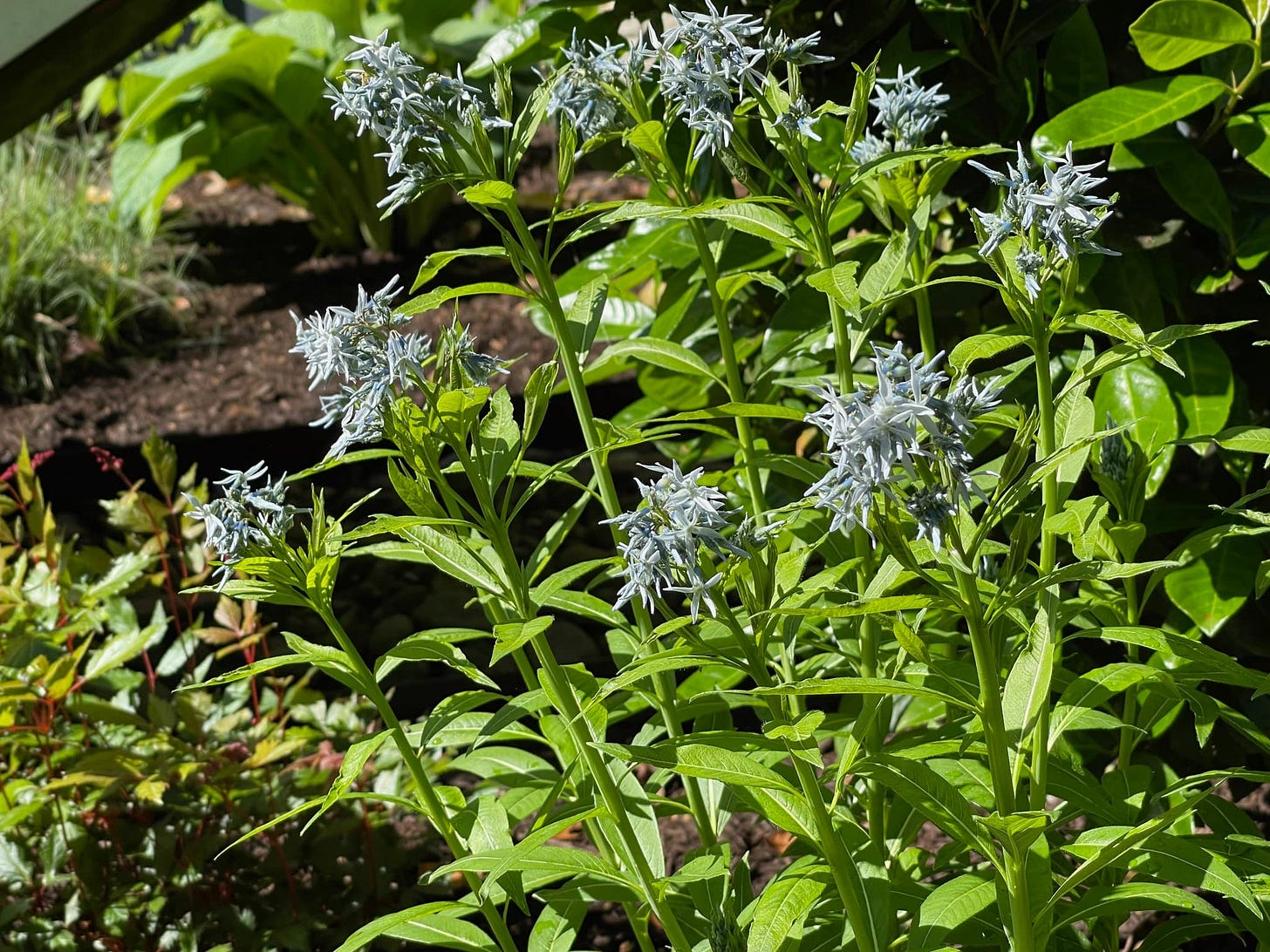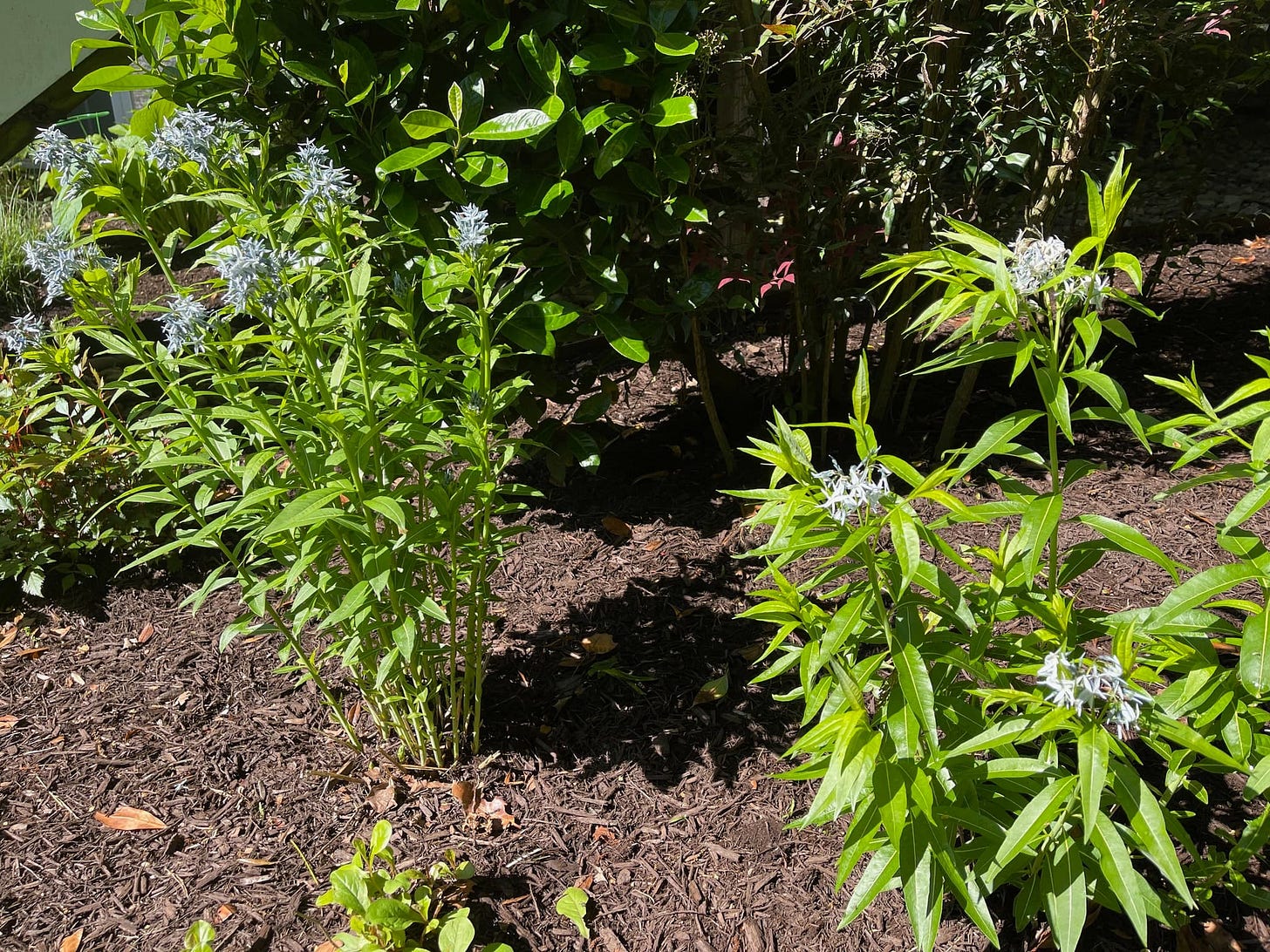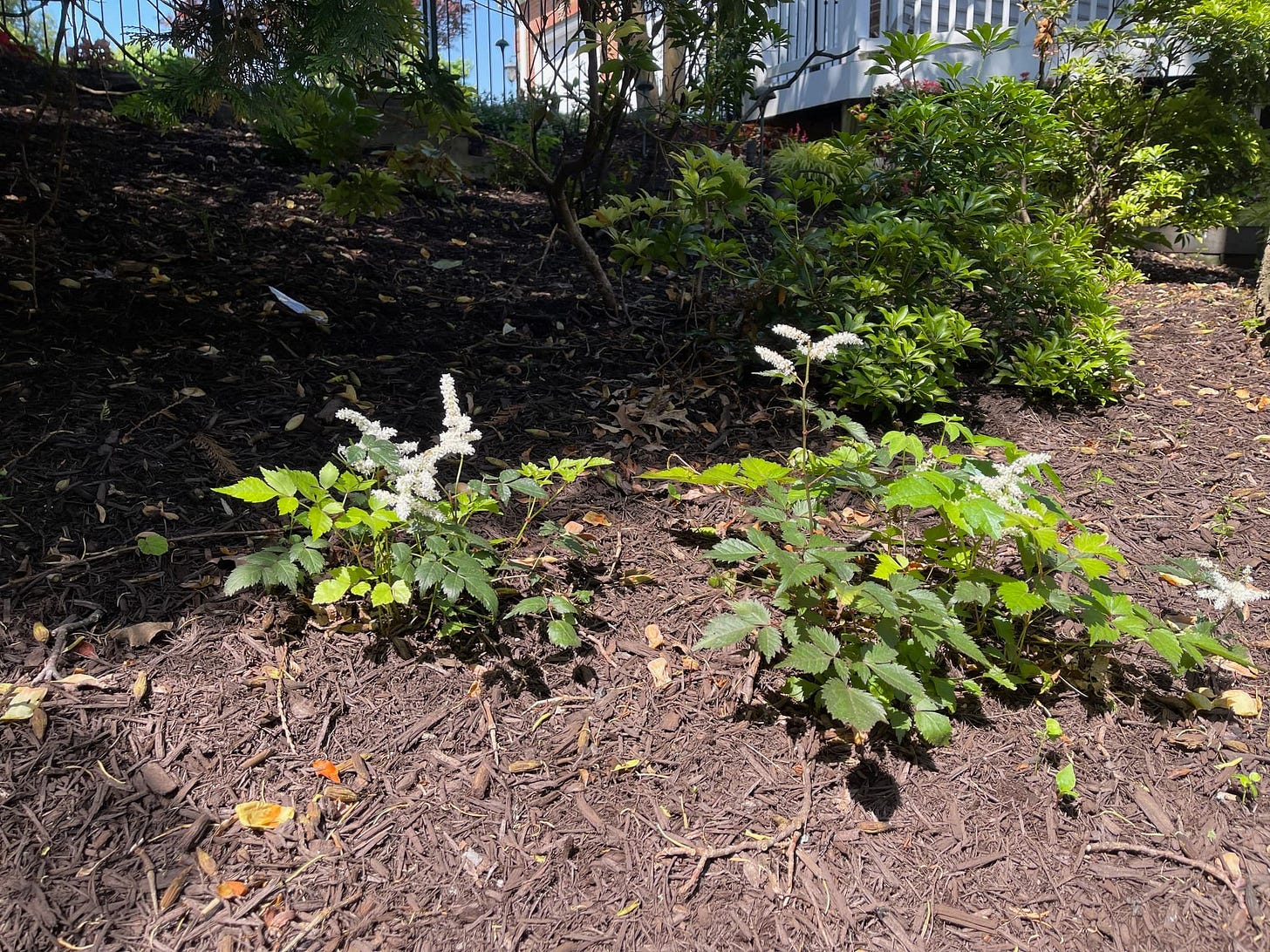I don’t know about you, but this time of year I read a lot of articles written by gardeners who are stuck between seasons when it seems like no flowers are blooming. Our spring flowers have come and gone with great excitement, and our summer blooms show promise but just aren’t there yet. For me, this is an ongoing challenge because 1) I have a shade garden and my summer flowers take forever to blossom because they don’t get as much sun as other beds, and 2) because of the shade I’ve tried to introduce color in many of my beds by installing plants with beautiful foliage, which is nice, but isn’t the same as a burst of summer color to replace my spring blossoms. Despite these concerns, I think Sasha, my designer at Sun Nurseries, and if I may so, myself, have done a pretty good job of planning for seasonal color. I thought it might be interesting to look at the garden through the lens of what might be blooming as the year progresses.
I’ve tried to keep you up to date with the spring bloomers, in many cases because I’m still startled that they show up each year. My earliest blooms come from my Lenten rose in my steps bed, where the plants burst into color from March until early May. The Lenten rose is closely followed by daffodils, a new addition this year, and my Jack Frost brunnera, which offer startling blue flowers throughout the month of April. There are other spring bloomers worth mentioning, especially the blue star (amsonia) plants that grow in my back bed. The blue star transplants were originally planted along the west side of my old gazebo. The location was great for seeing them from the house, but unfortunately, they weren’t getting enough sun to thrive. I moved two of the plants to the back bed, and now they put on quite a show through the month of April.


I’ve recently written about the new foxglove plant that probably counts as a late spring bloomer. I think it’s going to flower through the early summer and then leave us for a year while it reseeds itself. In the same bed is a groundcover called dead nettle lamium that blooms in early spring and continues through the summer. Other early spring-blooming groundcovers include epimedium and shale barren sedum, both of which have had their moment and won’t be contributing to garden flowers for the rest of the summer.
There are many other plants that are about to bloom, or are just short of full bloom, in a variety of flower beds. Most notably, the red and white astilbe are popping all over the garden. The red astilbe are frustrating because they start with dark red blossoms for weeks and then, finally, burst into a brilliant red hue. I think we are a few days (weeks?) away from brilliant red, so I’m not sure how to count the red astilbe that are awash in dark red. I’ve transplanted the red astilbe all over the garden, including both sides of the steps bed and underneath the arborvitae trees. I guess blooming this time of year counts as early summer, or late spring? I also transplanted white astilbe from their home around the old gazebo to the woodland garden behind the arborvitae trees. Unlike the red astilbe, the white ones have fully bloomed, and their white color is beautiful next to the ferns and other plants in the woods. The astilbe will be finished by early July. (I’m planning to write an “Ode to My Astilbe” in the next few weeks. They deserve their own piece.)


One last tweener that is helping to fill in some color while I’m impatiently waiting for my summer bloomers is my big leaf hydrangea. This one, under the deck where I do the grilling, is blooming like crazy this year. So is Pop Pop’s hydrangea in the astilbe bed. Even the hydrangea back by the sun bed is throwing out a few blossoms. All are helping to add color while I wait for my summer plants to get going.

So which plants are we waiting for, hoping they’ll start blooming soon?
Plumbago ground cover – back bed, waterfall bed
Blue Veronica - Firepit bed (throwing off buds as I write)
Daylilies - Firepit bed, sun bed (first daylily flower spotted this morning in the sun bed.)
Rozanne geraniums – Waterfall bed (a few flowers have made their appearance.)
Coneflowers - Sun bed (flower buds spotted this morning.)
Shasta daisies - Sun bed
Yarrow - Sun bed (tiny buds spotted)
Coreopsis - Sun bed
Little Lime Hydrangea - Sun bed
And what about plants that bloom in the fall, you ask? They would include:
Turtlehead (last year’s plant of the year award winner.)
Autumn Joy sedum (if the birds don’t eat them.)
Toad lilies – back bed and steps bed
If you properly prune your spring- and summer-blooming flowers, it is possible that you can get a second bloom from them in the fall. I’m not good enough to figure out this “deadheading” or pruning thing, but I’m going to give it a try this season and see what happens.
It has come to my attention that the solution to the problem of lacking consistent color in your beds throughout the year is adding annuals to the garden. Annuals allow you to add brilliant colors strategically throughout the garden and eliminate the issue of the seasonal “lull” in flowers blooming. You might ask, when am I going to add annuals to my garden? The answer is, soon. Which is, of course, the same answer I gave last year, but this year I mean it. In fact, I’ve purchased a handful of annuals and I’m looking forward to getting them in the ground.
Readers note: If you find yourself getting lost in all the flower references, I’ve given readers a complete tour of the garden, complete with diagrams of all the plants, in previous posts. To find them, click on the small image of me at the top of the post and it will take you to the archive.
I have one or two beds that are bursting with plant material and will give me color throughout the year. The rest of the garden is so spread out with beds all along the back and sides of the house that you must pick and choose where to find the plants that are blooming at any one time. And that’s OK with me. It gives me plenty of room to make colorful additions to the garden in the years to come.
This time of year, it’s hard to keep you up to date on all the news in the garden. Next week I’m going to “open my mailbag” to give you some insights into the questions I get every week about the newsletter. After that, I think we’ll celebrate the “popping” of my astilbe plants, an event I’ve been anticipating for several weeks. I hope you’ll join me next week.
If you enjoy this content and you think a friend or associate might like it too, please click on the share button and share the link to the newsletter with them.




A few suggestions for annuals for folks like us with a heavy deer population: for shade, begonias of any variety and for sun, Vinca.